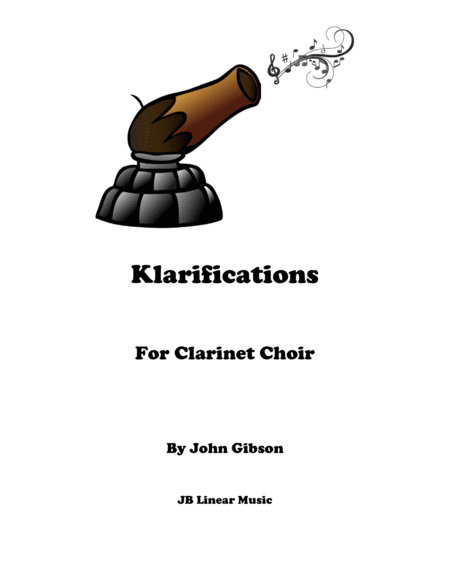Woodwind Ensemble Bass Clarinet,Contra Alto Clarinet,E-Flat Clarinet - Level 5 - Digital Download SKU: A0.581881 Composed by John Gibson. Contemporary. 90 pages. JB Linear #3012617. Published by JB Linear (A0.581881). Klarifications for Clarinet Choir is a three movement piece for a large clarinet choir. It is set for Eb Soprano (one player), Bb clarinet 1-2-3, 2 alto clarinets, 2 bass clarinets, and Bb Contra. This would be best in a clarinet choir with at least two on a part in the Bb clarinet section. Here is what Margaret Thornhill wrote about this piece in The Clarinet magazine, June 2017: The dramatic first movement is a dialogue between an eefer (Eb clarinet) and the rest of the ensemble, incorporating paraphrases of excepts from Bach to Bizet. It is followed by a surprising second movement chorale with slap tongue, flutter tongue and finger popping intended to be individually miked. The final movement is an exciting montuno, including a section where each person can choose which riffs to play.The 1st movement, Canons Firing From an Ever Rising Staircase, Or, Heed the Effer's Frantic Calls To explain the title just a bit, the ever rising staircase is an aural trick that, if done precisely, sounds like the music keeps rising without really doing so. This was derived from what is called a Shepard's Tone. The canons firing are not cannons! The bass instruments play small sections of actual canons (like fancy rounds) written by J S Bach, Mozart, and others. Each time the solo Eb clarinet (the Effer) announces the coming canon firing in a frantic sort of way. The 2nd movement (Close Encounters with Basses) makes use of a number of unusual sounds on clarinet (or parts thereof) along with a few extended techniques that are fairly easy to play with the clear instructions provided. The altos, basses, and contra should be closely miked to be heard.The 3rd movement (Sometimes Free - A Montuno) starts off with a rich beat in the basses and gradually joined with the rest of the clarinets. In the montuno section there are 4 bar phrases each player can choose from to play during the 32 bars. They may choose what they will, either playing a different variation each time, using the same one each time, or choosing to not play for a particular 4 bar section. This is not a free improvisation, however! This is definitely for an advanced group of players. The 1st movement is also available separately. The sample recording uses Finale software in the 1st and 3rd movement, and John Gibson's recording of the 2nd movement.
